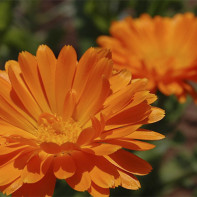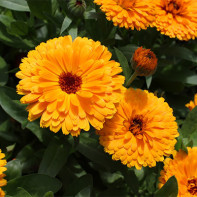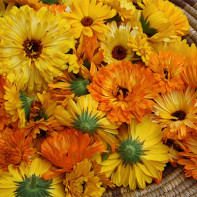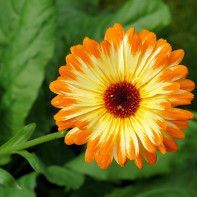Calendula: medicinal properties and contraindications
The people call this plant "marigolds", it is grown in flower beds and flower beds, decorating the yards with its bright flowering for almost the entire season. Calendula is not just a beautiful flower, it is a universal medicinal plant that helps to cope with dozens of different diseases. The healing properties are confirmed by science, so calendula is included in the pharmacopeias of different countries.
- Chemical composition
- How it looks and where it grows
- Views
- Collection and storage
- The healing properties of calendula
- For women
- For men
- During pregnancy
- When breastfeeding
- For children
- When losing weight
- Calendula in folk medicine
- With diabetes
- With pancreatitis
- With gastritis
- For the intestines
- For constipation
- With gout
- With colitis
- For the liver
- With hemorrhoids
- With cholecystitis
- With angina
- When coughing
- With thrush
- With a cold
- With otitis media
- With cystitis
- With menopause
- With chickenpox
- With dermatitis
- With mastopathy
- With gum disease
- In oncology
- With psoriasis
- With prostatitis
- For allergies
- With herpes
- With arrhythmia
- With sinusitis
- With varicose veins
- Types of medicinal compounds with calendula
- Infusion
- Tincture
- Decoction
- Tea
- Ointment
- Candles
- Calendula Pharmaceuticals
- Calendula oil: properties and applications
- Application in cosmetology
- Whitening mask
- Steaming skin
- Tonic for problem skin
- Calendula in cooking
- Calendula Cheese Salad
- Filling
- Seasoning
- Can calendula be given to animals
- Contraindications
- Interesting facts about calendula
Chemical composition
Calendula is one of the most popular medicinal plants; it can be bought at every pharmacy. Moreover, it is grown by many on their own, because it is a universal tool that can be used both for treatment and for the prevention of various diseases. The invaluable benefits of the plant are due to its rich chemical composition. To find out how useful this herb is, you should study its chemical composition.
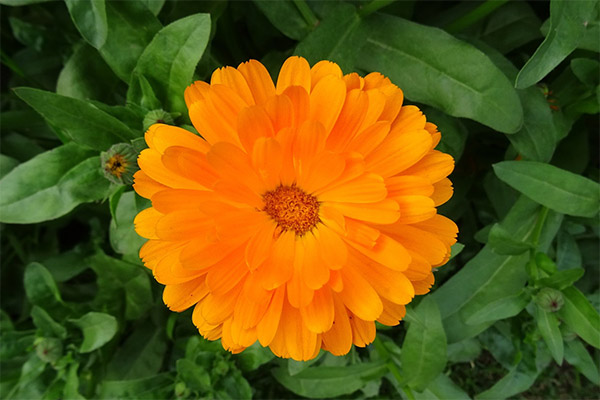
- Flavonoids are herbal natural ingredients with antispasmodic, healing, diuretic and antioxidant effects. They strengthen the immune system and have antiviral efficacy.
- Carotenoids are plant-based natural pigments that color inflorescences in a bright orange color. The same substance is found in carrots and pumpkins. Carotenoids neutralize the effect of free radicals. The most valuable varieties of these substances are present in marigolds in high concentration - this is provitamin A.
- Essential oils are also found in calendula, they are effective against pathogenic microorganisms, and they are also powerful stimulants that stimulate the body to activate recovery processes.
- Triterpenoids are plant substances that contain acids, they help with gout, have an anti-inflammatory effect, affect the conductivity of nerve impulses, in the long run they cleanse blood vessels and lower cholesterol.
- Sterols are an analogue of human hormones, steroid substances. They dissolve cholesterol, support the liver, support the health of the reproductive system.
- Salicylic acid is an organic compound that has antiseptic, anti-inflammatory, analgesic, antirheumatic effects.
- Coumarins are active substances that stop the growth of tumors, block the development of viruses and bacteria, and stimulate the immune system.
- Lutein is an organic pigment that supports eye health and normalizes the functioning of the nervous system.
These are not all active substances that are present in calendula inflorescences. Also in this amazing plant found such components:
- Zinc - important for healthy skin and hair, increase immunity.
- Potassium and magnesium - to support the water-salt balance, heart and nervous system.
- Iron and calcium - for the health of the musculoskeletal system and normal blood formation.
- Copper - for blood formation, hormonal balance and the elimination of inflammatory processes.
- Selenium - for the prevention of cancer, stopping the growth and development of atypical cells, the normal functioning of the endocrine and reproductive systems.
- Molybdenum - for healthy teeth, beautiful hair and nails, from infections.
The stems and leaves of calendula are also not useless, but they are used at times less often in folk medicine. They contain resins and esters, thanks to which the plant can be used as an antibacterial agent and a source of tannins. The seeds of this plant are of high value - they contain fats in large quantities and are used to produce oils with medicinal properties.
How it looks and where it grows
Calendula is a genus of herbaceous plants, perennials and annuals. This genus is included in the Astrov family and therefore has similar botanical characteristics. Calendula around the world is officially recognized as a medicinal plant, therefore it is often used by pharmaceutical companies for the production of drugs.
Botanical characteristics of this plant:
- height - from 30 to 70 cm;
- green pubescent leaves;
- rosette of basal leaves;
- apical inflorescences, baskets;
- teardrop or oval leaf shape;
- the color of flowers - from light yellow to bright orange.
Calendula is propagated by seeds and vegetative methods, but the easiest way to grow it is by sowing. Germination potential persists in seeds for a long time - up to three years. In addition, calendula is actively propagated by self-sowing, so those who grow it on their site should monitor the ripening of seeds and remove them in a timely manner.
Calendula is distributed mainly in Eurasia, the largest number of varieties grows and is cultivated in the European part of the continent. This is a very hardy and unpretentious plant. In the southern regions, one can observe the flowering of this plant even before frosts. Calendula has pronounced decorative qualities, so it is used in landscape design. This flower is famous for its long flowering, so it can decorate flower beds and flower beds throughout the season.
Views
According to various sources, in the genus calendula, there are from 12 to 20 species. Some of the varieties are rare and have unexpressed botanical characteristics, so the classifiers had problems with the identification of these plants. But today, three varieties are recognized as the most common options that are found everywhere.
- Calendula officinalis is the most popular species, used for medicinal purposes and grown as an ornamental plant. It is cultivated on an industrial scale. This flower is grown for pharmaceutical companies in regions with good ecology and low radiation.
- Field calendula is a wild-growing variety that has the same healing properties as the previous species. This plant has smaller flowers, reaches a maximum height of 40-50 cm.
- The third variety is a whole group of subspecies, all kinds of hybrid varieties that are created for decorative purposes, but are also used in folk medicine.
Calendula officinalis is a leader in the concentration of active components that positively affect human health. You can grow it at home in garden areas. In order for the raw materials to turn out to be environmentally friendly and harmless, it is necessary to plant flowers far from highways and not use toxic chemical fertilizers. And without them, calendula grows well and gives abundant flowering, the main thing is to choose a good sunny area and provide the plant with regular watering.
Collection and storage
For those who do not have the opportunity to independently collect and procure medicinal raw materials, each pharmacy sells ready-made, already dried calendula - in paper bags or packaged.But if there is a desire to independently prepare raw materials for future use, you must adhere to such rules.
- Choose an environmentally friendly collection point where there are no factories and enterprises with toxic emissions.
- Cut off only the inflorescences, and do this before the seeds begin to form.
- The ideal time to collect is early morning, when the dew just managed to dry.
- Do not collect calendula after rain or heavy watering.
The flowers must be carefully cut with sharp garden shears and put in a box or basket. At home, spread a clean cloth and dry flowers on it naturally for 5–7 days. When the flowers are completely dry, put them in bags or storage boxes. You can keep the raw materials in glass jars. The recommended period of use is 1 year, but you can store vegetable raw materials for 2 years as long as possible.
The healing properties of calendula

Calendula officinalis is a powerful therapeutic agent that can be used for various health problems. Its beneficial properties are so diverse that they can be used for a wide variety of diseases. Here is a general list of healing properties:
- immunomodulatory;
- antibacterial;
- antifungal;
- bactericidal;
- antiviral;
- anti-inflammatory;
- soothing;
- antispasmodic;
- painkiller;
- antitumor;
- anticoagulant;
- antitussive;
- expectorant;
- anticonvulsant;
- diuretic;
- sweatshops;
- antipyretic;
- tonic.
In addition, calendula is capable of affecting the human body in different ways, depending on gender, physiological condition and age. Therefore, you need to know how calendula is useful to men and women, how it can affect children's health, and also what is good in this herb for pregnant and lactating women.
For women
Calendula is useful for women's health, it can normalize the hormonal background and help cope with a number of diseases of the reproductive system. The plant contains plant hormones in its composition, which have a beneficial effect on the functioning of the reproductive system. It helps to cope with candidiasis, inflammation of the ovaries, infections of the genitourinary sphere.
Calendula is effective for hormonal disorders that lead to malfunctions of the menstrual cycle. This plant can also be used for skin and hair care, it helps to solve most problems that worsen the appearance.
For men
Men can also appreciate the beneficial properties of this plant. Calendula helps with infectious diseases of the reproductive system in men, strengthens the immune system and protects against most common types of cancer that are found in males. But it is important to remember that prolonged use of calendula can be harmful to men, since it contains phytohormones that are identical in structure and formula to female ones.
During pregnancy
Doctors do not recommend using calendula for treatment during pregnancy. But this ban applies only to the ingestion of funds based on this plant. If necessary, you can use infusions and ointments externally, for gargling and treating problems of the oral cavity.
Calendula during pregnancy can be used by women to maintain the beauty and health of the skin. Often, due to hormonal imbalances, acne and pigmentation appear on the skin. The use of potent chemical cosmetics can harm, and a small dose of plant substances that enter the body through the skin will certainly be safe. Therefore, do not worry.
When breastfeeding
Doctors do not prohibit the use of calendula during breastfeeding. This plant extremely rarely provokes the appearance of allergic reactions, but still, internal intake is not recommended. If you need to use plant materials inside, you need to temporarily stop breastfeeding.For external use, there is no need to stop feeding. Here's what calendula is for nursing women:
- helps with skin diseases;
- supports breast health (used for compresses);
- copes with colds (for gargling, inhalation);
- anesthetizes (in the form of compresses).
Calendula can be used orally for inflammatory processes, hormonal disorders, and also, if necessary, the treatment of various postpartum problems.
For children
Calendula is one of the few herbs that can be used for children from birth. But the first couple of years it is allowed to use this plant only externally, for the treatment of skin diseases. The plant effectively copes with different types of dermatitis in children, it is used in complex collections for children's baths. In pediatrics, the following properties of calendula are used:
- anti-inflammatory;
- antiseptic;
- regenerative;
- drying;
- antiallergic.
Calendula helps to cope with the most common childhood problem - prickly heat. When other remedies are prohibited, this herb can be used to prepare healing baths. After the procedure, the child becomes calmer, the rash decreases, the itching disappears. As a result of inhalation of vapors with essential oils contained in calendula, sleep and appetite normalize.
When losing weight
Calendula can be used by those who really want to lose weight without harm to health. This plant helps to normalize the speed of metabolic processes, cleanse the body of toxins and toxins. Calendula effectively stimulates the production of digestive enzymes of all types, so it helps to normalize appetite and establish a diet. When losing weight, calendula is used inside as tea. You can also combine this plant with other herbs that enhance the effect of losing weight.
Calendula in folk medicine
In folk medicine, there are dozens of ways to use calendula. For each individual diagnosis, the prescription of the drug, the method of administration, dosage, and also the duration of treatment are different. It is important to know how to properly use this herb in each case in order to get the most benefit from it.
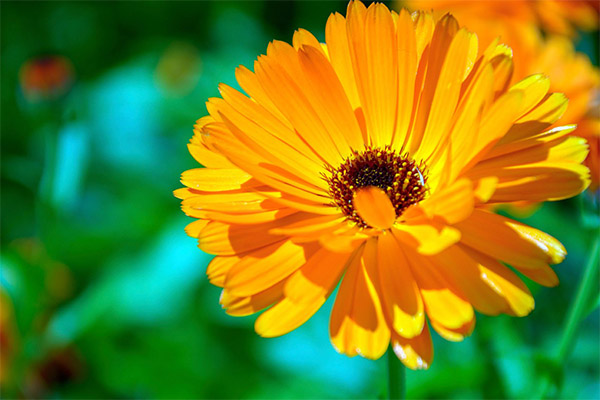
With diabetes
Numerous studies have confirmed that calendula is effective in treating diabetes. Of course, it will not work out completely with the help of grass, but this plant helps to reduce the risks of complications, protects the body from hypoglycemia and hyperglycemia, cleanses blood vessels and stimulates metabolic processes. Diabetics are advised to take tea from calendula flowers 2 times a day. If there are no contraindications, you can use this medicine for 2 months, and then take a break for the same period of time and repeat.
Tea is brewed immediately before use. It is necessary to take an incomplete teaspoon of dried marigold inflorescences, steam with a cup of boiling water and let stand for 5-7 minutes under the lid. After that, you can immediately filter the drink and drink it by adding sugar substitutes or fructose syrup to such tea.
With pancreatitis
Calendula is useful for pancreatitis for three reasons. It stops the inflammatory processes, eliminates the bacterial microflora, normalizes the production of pancreatic enzymes. But calendula is forbidden to use during the period of exacerbation, when the pancreas and without stimulation produces too much digestive enzymes.
To eliminate inflammation in pancreatitis, you need to take calendula tea 3 times a day for 3 weeks. It should be brewed immediately before taking. When the tea is warm, it must be filtered and drunk, and after 15 minutes eat. Tea needs to be prepared from 1 teaspoon of inflorescences and a cup of boiling water.
With gastritis
With gastritis, you can use calendula to restore normal digestion, prevent the development of inflammatory processes and complications.With hypoacid gastritis, alcohol tincture is used - you need to drink it ½ teaspoon before each meal. You do not have to worry about the fact that the medicine is for alcohol - in this dosage, ethanol does not affect the ability to drive a vehicle or perform any tasks that require an increased concentration.
With gastritis with high acidity, it is better to drink tea or water infusion. Tea can be prepared immediately before meals and immediately drunk when infused (3-5 minutes). It is better to prepare the infusion in advance - brew 250 ml of boiling water with 1 tablespoon of grass and insist for 2 hours, drink 50 ml.
For the intestines
In case of violation of intestinal motility, inflammation, dysbiosis, it is recommended to eat oatmeal brewed with hot infusion or a decoction of calendula. If you eat such a dish for breakfast every day for 2 weeks, you can quickly and effectively cope with the inflammatory process, normalize the motor function of the intestines and normalize the microflora.
You can also use infusion for treatment. With intestinal tumors, it is used as a daily enema. In other diseases that are accompanied by an acute inflammatory process, an aqueous infusion is used to restore the intestinal mucosa. It is taken before meals for 10-15 minutes, 50 ml each. Preparing the medicine is very simple - you need to steam 20 g of herb 1 liter of boiling water and stand for 2 hours.
For constipation
Chronic constipation can be treated by ingestion of calendula on an empty stomach. In the morning, you need to breed 1 tablespoon of the product in 1 glass of water and drink 30 minutes before eating. Also, for constipation, you can use calendula oil, taking 1 teaspoon 2 times a day. The main thing is to follow a diet during treatment, consume large quantities of vegetables and cereals, refuse fast food, fatty and spicy foods.
With gout
With gout, calendula is used as a powerful source of organic acids and components that can break down crystals of uric acid salts. The most effective combination of external use with oral administration. With gout, the use of alcohol tincture is strictly contraindicated inside, therefore a decoction and infusion are used. It is necessary to take 100 ml of decoction or infusion 2 times a day for a month, and externally use alcohol tincture for compresses.
With colitis
With intestinal inflammation, the antiseptic, antibacterial and anti-inflammatory potential of the plant is used. You can apply calendula in two ways.
- During the acute stage, drink tea from calendula 1 cup 3-4 times a day for 3-5 days.
- When the inflammatory process calms down a bit, make enemas with a decoction. For 2 tablespoons of raw materials, take 100 ml of water and boil for 15 minutes.
In chronic colitis, it is recommended to use calendula tincture for long courses of 4-6 weeks, drink 20 drops before each meal.
For the liver
With liver diseases, calendula stimulates blood supply to this organ, and also eliminates the inflammatory process in viral hepatitis. It must be applied in long courses of 3-4 months. The first month you can use the infusion of calendula 1 tablespoon 3-4 times a day. Then reduce the dosage by 1.5–2 months and drink 1 tablespoon 2 times a day, and leave only one dose per day for the third or fourth month.
With hemorrhoids
With hemorrhoids, calendula relieves inflammation, reduces the size of nodes, and also protects against complications. You can use these three recipes.
- Prepare candles from 50 g of pork fat, 2 tablespoons of calendula and 20 g of coconut oil. Boil all the ingredients on a minimum heat for 15 minutes, strain and pour into molds using plastic wrap or rubber medical gloves.
- Brew infusion, strain through cheesecloth. Cake to use for compresses. The procedure is repeated 2 times a day.
- Lubricate hemorrhoids 2 times a day with calendula oil.
It is also useful to combine outdoor use with tea from the herb. Drink 1 cup 2 times a day.
With cholecystitis
Calendula contains bitterness, as well as substances that tone the walls of the gallbladder. Therefore, when using this herbal remedy, bile production is stimulated, the motor function of the gallbladder is normalized, which is necessary for cholecystitis. It is necessary to use the infusion of calendula before each meal, 1 tablespoon, washed down with warm boiled water. To prepare the infusion, you need to do this - pour a glass of boiling water 2 tablespoons of herbs and stand under the lid for 20-30 minutes.
With angina
Calendula is very effective in treating tonsillitis of viral and bacterial etiology. Plant materials can be used in the form of alcohol tincture or water infusion. For the treatment of tonsillitis, it is necessary to use calendula as the basis for the preparation of solutions that need to gargle.
- Tincture: 1 tablespoon per 150 ml of water, gargle 5-7 times a day.
- Water infusion: 2 tablespoons of collection per 500 ml of water, gargle 5-7 times a day.
The main rule of rinsing is to do this after eating, drinking or taking medication. It is important that the person does not eat or drink anything after the procedure for 30 minutes.
When coughing
For cough, calendula is used in the form of tea and alcohol tincture. Tea must be prepared fresh before each meal. To recover faster, you need to drink tea 4-6 times a day. Alcohol tincture must be used to rub the chest. This activates blood circulation, as a result of which the body quickly absorbs the components of the plant. Calendula provides anti-inflammatory, expectorant and antibacterial effects. Essential oils, which are contained in inflorescences, facilitate breathing and block attacks of dry cough.
With thrush
With candidiasis, you can use a calendula decoction for douching. It is important to use a decoction, not an infusion, since boiling kills all microbes and minimizes the risk of bacterial infection. The broth should be prepared like this - take 2 tablespoons of dried inflorescences per 300 ml of boiling water and boil over low heat for 30 minutes. After this, strain the product and after cooling use as directed.
With a cold
You can cure a cold many times faster with calendula tea. It is necessary to brew it 4-5 times a day and drink with the addition of linden honey. You can prepare a mixture of herbs and brew tea from it. It is necessary to take in equal parts calendula, chamomile, bird highlander and linden. Brew 1 teaspoon in a cup of boiling water and drink hot. You can boil 1 tablespoon of calendula in 0.5 l of non-skim milk and drink throughout the day 4-5 times in 100 ml. It is also good to use calendula for symptomatic treatment, instill a decoction in the nose with a bad cold, gargle, breathe steam to block the inflammatory process in the airways.
With otitis media
With exudative otitis media, it is necessary to use alcohol tincture - drip 1 drop in each ear, even if inflammation occurs in only one. Calendula tincture eliminates the inflammatory process, dries and prevents bacterial infections from penetrating further. With purulent otitis media, it is necessary to use a strong decoction - drip 2-3 drops in each ear 3-4 times a day. For external otitis media, compresses with alcohol tincture of calendula can be used. For chronic otitis media, you should clean your ears with a cotton swab dipped in calendula infusion, 1 time per day for 30 days.
With cystitis
With cystitis, the antibacterial and anti-inflammatory, as well as the diuretic potential of this plant is used. You must use it in three ways.
- Brew 20 g of grass with 2 l of water, wait until the infusion has cooled to 45 degrees and use it for a bath 2-3 times a day.
- Use an aqueous decoction of calendula for washing to eliminate a bacterial infection of the urinary tract.
- Inside, take alcohol tincture of the plant 20 drops 4 times a day.
Calendula with cystitis stops the inflammatory process, stimulates the body's defenses to fight infection and improves well-being.
With menopause
Calendula is rich in plant hormones, so it helps to cope with the symptoms of menopause. It reduces the frequency of hot flashes, normalizes hormonal levels, and removes bouts of weakness and dizziness. You can use a combined tincture of calendula with a red brush (1 teaspoon 2 times a day) or separately boil boiling water (1 teaspoon of plant material) and drink 3-4 times a day such tea.
With chickenpox
Chicken pox is a disease that is commonly found in children. But often, adults who did not have time to acquire immunity to this virus in childhood suffer from chickenpox. The problem is that there are no effective medicines for it, it is a disease that the body must defeat on its own. Despite this, with chickenpox, drugs are used that facilitate the process of the disease and reduce the intensity of the symptoms.
The main manifestation of chickenpox is an itchy rash throughout the body. And to cope with this symptom, a regular calendula can help. You can use a strong infusion of flowers to rub the affected areas of the skin or compresses with severe itching. Alcoholic tinctures of the plant can be wiped with bursting blisters to disinfect the skin and avoid the attachment of a bacterial infection.
With dermatitis
Dermatitis develops for various reasons. They may be infectious, allergic or neurological in nature. Depending on the reasons, various treatment methods are used, but calendula-based products may be present in any therapeutic complex. There are many ways to use grass for dermatitis. Here are 3 of the most popular recipes.
- To cook an oil extract - grind in vegetable oil (250 ml) 2 tablespoons of calendula for 30 minutes at a temperature of 60 degrees, cool and strain. Lubricate affected skin 2-3 times a day.
- To prepare a decoction from the grass - pour 20 g of grass with cold water (500 ml), wipe the skin with dermatitis 3 times a day with a cotton swab.
- Brew 2 tablespoons of herb 400 ml of boiling water, insist and cool. Do compresses for 20-30 minutes 2-3 times a day.
After the first application, you can notice positive effects. For complete recovery, you need to use calendula for 5-7 days.
With mastopathy
With mastopathy, you can use the infusion of calendula inside, you need to brew 50 g of herb 1 liter of boiling water and drink 150 ml 3 times a day. The cake that is left from the infusion should not be thrown away; it must be collected in a clean bandage or gauze and used for compresses - applied to the sore chest once a day for 30–40 minutes.
With gum disease
From gum inflammation, calendula can be used only if there is no bleeding, otherwise the plant can aggravate the condition and provoke even more bleeding. With gum disease, alcohol tincture is used. It is necessary to dissolve 1 tablespoon of tincture in a glass of clean boiled water and rinse your mouth 3-4 times a day for 1 week.
In oncology
Calendula contains substances that can block the development of cancer cells and destroy some types of cancer. Use of calendula for the fight against malignant tumors is allowed only as part of complex therapy - it will not replace cancer pills.
For cancer of the reproductive system in women, calendula suppositories are used vaginally, and they also drink a decoction of the herb 150 ml 2 times a day. For other types of cancer, only an infusion of 50 ml 2 times a day before meals is used. Infusion must be prepared in a thermos for 4-6 hours, brewing 20 g of herb 50 ml of boiling water.
With psoriasis
In psoriasis, the most effective dosage form is an oil extract. Fatty oil made directly from the seeds of the plant is also used.An oil extract is used to rub into the affected areas of the skin 2 times a day for 14 days. It can be used once if an exacerbation has begun. Inside, you need to take 1 teaspoon of tincture 1 time per day. Calendula oil is also used externally for rubbing and compresses.
With prostatitis
Curing prostatitis is quite simple with calendula. It is used in the form of water infusion. If the problem has become chronic, it is necessary to drink an aqueous extract of calendula for 30 days, 2 times a day. In acute inflammatory process in the prostate gland, it is better to use an infusion of 100 ml every 3-4 hours. You can cook it from 20 g of grass and 700 ml of boiling water, keeping in a closed container under a lid for 2 hours.
For allergies
All kinds of skin allergic reactions are treated according to the same scheme as dermatitis. For wiping, such means are used:
- water decoction;
- alcohol tincture;
- oil extract;
- ointment.
You can prepare a multi-component ointment for the treatment of allergic rashes. It is necessary to take 20 g of chamomile, 30 g of calendula and 10 g of a string. Boil all this in 300 ml of vegetable oil over low heat for 20 minutes. After that, let the ointment cool, strain it and pour into a jar for storage. Use twice a day.
With herpes
Ulcers on the skin and mucous membranes with herpes must be treated with alcohol tincture diluted with boiled water in a ratio of 1: 1. You can also moisten a cotton pad in an oil hood and apply for 15–20 minutes. Calendula blocks the development of the virus, dries and accelerates tissue regeneration in cold sores.
With arrhythmia
Calendula is one of the most popular cardiac herbs; it can be used to normalize the functioning of the heart. With arrhythmias, it is recommended to block the attack by taking tincture of calendula inside in the amount of 1 teaspoon. Tincture should be washed down with plenty of water.
In the long run, the plant can help cope with the disease. It is necessary to brew 1 liter of boiling water 2 tablespoons of flowers and drink, when it cools, 100 ml 2 times a day.
With sinusitis
With sinusitis, calendula tincture for compresses is used. It is necessary to moisten small segments of the bandage in the product and apply to the maxillary sinus region for 30–40 minutes. It is also useful to use the infusion inside - drink 100 ml 3-4 times a day with exacerbation. You can instill a decoction of the plant in the nose 2-3 drops 2 times a day.
With varicose veins
Calendula is one of the most effective plants for the treatment of varicose veins. Inflorescences of this plant can be used fresh. They must be passed through a meat grinder, pour honey, insist 1 hour and use the resulting slurry for compresses on sore skin. You can also use calendula oil - it must be applied daily to the affected areas before bedtime. You can use it 2 times a day if you do not need to go anywhere. It is important to remain dormant after applying the oil.
Types of medicinal compounds with calendula
Calendula medicines can be prepared in many ways, depending on which disease needs to be cured. Also, when choosing a recipe, the individual characteristics of the body are taken into account. For example, with liver diseases, hypertension or diabetes mellitus, it is strictly forbidden to use products prepared with vodka or alcohol.
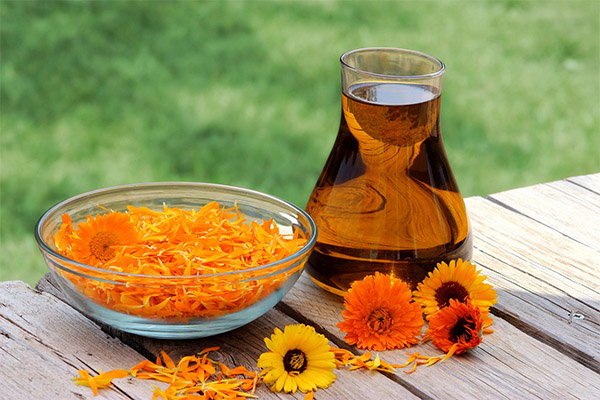
But with some diseases, water infusions are ineffective, so you need to select a prescription depending on the characteristics of the body, diagnosis and personal preferences. It is easier for someone to drink tea than 1 tablespoon of tincture, and for someone - to drip 20 drops of alcoholic extract on sugar, since the water infusion is quite bitter.
Infusion
To prepare water infusion is very easy - there are 2 ways to prepare. In the first method, boiling water (600 ml) and 2 tablespoons of collection are used. It is better to cook the infusion in a container with a lid, keeping it for 2 hours, and then filtering. It should be stored in the refrigerator and drink 50 ml.
The second method of preparation allows you to get a more concentrated drug.It is necessary to pour 500 ml of boiling water in a thermos 2 tablespoons of grass and leave for 5-6 hours. After this, strain the infusion and drink 50-60 ml before meals.
Tincture
You can prepare tincture from 100 ml of alcohol and 1.5 tablespoons of dry raw materials. It is necessary to withstand tincture in a dark place for 3 weeks. Approximately every 3-4 days, it is recommended to shake the tincture - this will make it more concentrated. After 3 weeks, you can already strain the product, pour into a glass bottle and store in a dry, dark place at a temperature of no higher than 25 degrees. The maximum duration of use of such a tool is 1 year.
You can prepare tincture of calendula not on alcohol, but on vodka or moonshine. But in this case, the proportions are slightly different. For every 100 g of vodka you need to take 2 tablespoons of raw materials. For 0.5 l, take a glass of dry grass, pour vodka and stand for 2 weeks in a dark place, and then strain and pour into a container that will be convenient for using the product.
Decoction
You can prepare a decoction of dry and fresh marigold inflorescences. But it is better to use dry raw materials, since it has a higher concentration of nutrients. The broth is prepared from 20 g of grass and 1 liter of water. It is necessary to boil the medicine in a steam bath for 15-20 minutes, and then cover, tightly wrap a blanket and leave for another couple of hours. When ready, strain and store the broth in the refrigerator.
Tea
Calendula tea is a universal remedy that helps with a variety of diseases. Its main advantage is that it is simply preparing. Calendula tea can be taken for medicinal purposes and for prevention. To prepare such a medicine, you need to pour 1 teaspoon of the herb in a cup of 250 ml of boiling water and stand for 5-7 minutes, covering the container with a lid. Strain and drink tea, you can add honey and sugar.
Calendula tea can be prepared in other ways, for example, pour 2 tablespoons of inflorescences into a teapot for brewing, pour boiling water over and use as a brew. They also recommend picking fresh flowers and adding to tea. This plant can be mixed with black or green tea, it will make the drink more useful, and also saturate it with a delicate floral aroma.
Ointment
You can prepare a therapeutic ointment from calendula at home. There are several popular recipes. The first uses olive oil as a base. It is necessary to take a glass jar with a volume of 0.5 l, pour dry inflorescences so that they half fill the container. Then top up the warmed vegetable oil and close the lid. Infuse the ointment for 2 weeks, keeping the container in a dark place, but warm. After 14 days, strain through a sieve and store in the refrigerator, using as needed.
The second version of the recipe is to take 400 g of pork fat without salt and any additives, melt and pour 4 tablespoons of dried marigold inflorescences there. Stir in the oven at a temperature of 70–80 degrees for 20 minutes and strain. Keep the product in the refrigerator too.
Candles
In folk and traditional medicine, rectal suppositories made on the basis of calendula flowers are very popular. You can purchase them at a pharmacy or make them yourself. The recipe is quite simple, you need the following ingredients:
- 50 ml of calendula oil extract;
- 5 g of beeswax;
- 5 g of cocoa butter.
You need to mix the ingredients and warm to 60 degrees, and then pour into molds and use as directed. Suppositories can be used not only rectally, but also vaginally for the treatment of various infectious diseases of the reproductive system in women.
Calendula Pharmaceuticals
Pharmaceutical companies have long used the medicinal properties of calendula in their preparations. There are over two dozen pharmacy products, which include the extract of this plant. The acquisition of such funds facilitates the treatment, as it eliminates the need for independent procurement and preparation of drugs.Ointment (for treating skin integuments), tincture (for rubbing the skin and inside), suppositories (for oral administration) and dried raw materials (for the preparation of medicinal formulations at home) are the most common forms of calendula pharmacy products that can be bought without a doctor’s prescription .
Calendula oil: properties and applications
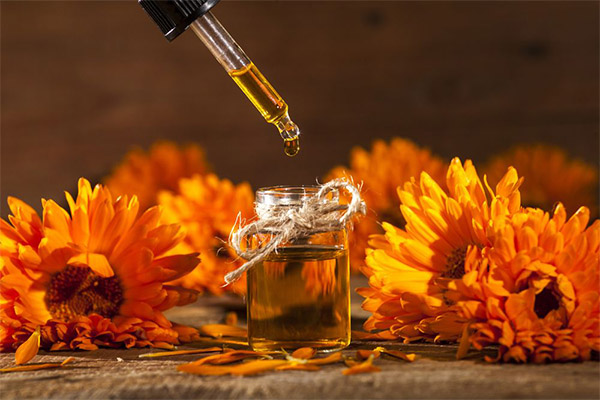
Calendula oil is an effective treatment for skin diseases. It is also widely used in the treatment of varicose veins, hemorrhoids, with abscesses and wounds, for recovery after surgery. Also, oil is used in cosmetology for the preparation of care products and cosmetics. This medicine has the following properties:
- eliminates inflammatory processes;
- disinfects
- normalizes the rate of cell regeneration, heals;
- softens the skin;
- eliminates pain and itching.
You can also use oil for stomatitis and gum disease - they lubricate the mucous membranes of the oral cavity 2-3 times a day. With varicose veins, oil compresses and dressings are applied to restore the capillaries and prevent the development of thrombosis.
Application in cosmetology
In cosmetology, the healing properties of calendula are also used. This plant is great for oily and problem skin, it can be used to restore dry and sensitive dermis, depending on the situation. There are 3 popular recipes that can be used for beauty and skin health.
Whitening mask
Since ancient times, calendula flowers have been used to remove excessive pigmentation on the skin of hands and face. You can use plant juice to prepare a mask for whitening the skin. Apply the juice of the plant in its pure form with massage movements to areas of the skin where there are age spots. Wash off after 10 minutes. You can mix calendula juice with lemon juice and tea tree essential oil (1-2 drops).
Steaming skin
If skin secretions often accumulate in the pores, due to which black dots form, you need to perform a fairly simple procedure once a week - brew 2 tablespoons of calendula flowers and keep your face above the steam until the liquid cools down. After that, you can use a gel or scrub to deeply cleanse your face - it will remove the remaining fat from the steamed pores, and the skin will be much cleaner. The anti-inflammatory properties of the plant will help prevent inflammatory processes.
Tonic for problem skin
If acne often appears on the skin, and the T-zone glistens from excessive secretion of the skin glands, you can use alcohol tincture of calendula 70% and aloe tree juice. You need to mix 60 ml of tincture and 2 tablespoons of juice, shake and wipe the skin after washing.
Calendula in cooking
Calendula is often used in cooking. This plant gives dishes a special aroma and taste. For those who want to diversify their menu, there are several interesting recipes.
Calendula Cheese Salad
For cooking you will need cheese platter - 200 g. You can take any kind of cheese, no more than three. It is necessary to grate the cheese, add 50 g of chopped calendula inflorescences and a bunch of chopped green onions. Season the salad with olive oil with mustard seeds and lemon juice.
Filling
Calendula is able to give a special flavor to alcoholic beverages and reduce the harmful effects of alcohol on the body. This cordial has a delicate taste and aroma. To make a drink, you need to boil 2 tablespoons of calendula flowers and 1 teaspoon of peppermint leaves in 200 ml of water for 5 minutes. Then strain the broth and add 1 cup sugar, boil for 5 minutes. When the syrup cools, mix it with 700 ml of vodka, shake and leave in the refrigerator for a day. Serve chilled.
Seasoning
You can make seasoning from the flowers of calendula, which can make any dish as useful and tasty as possible. It is necessary to dry in a dryer or oven at a temperature of 40 degrees fresh flowers at peak flowering. It is better to choose the largest and brightest inflorescences - they have the most carotenoids. Grind the dried flowers into powder using a coffee grinder or lay in a fabric bag and beat off with a rolling pin, and then sift through a sieve. Add dry powder to the first dishes, use with meat and fish, pilaf and salads.
Can calendula be given to animals
Calendula is effective not only in the treatment of human diseases. It can also be used for animals. Calendula is an effective treatment for various wounds - they can be treated with tincture. Water extract of calendula is an indispensable tool for the treatment of eye diseases. Water puppies are suitable for small puppies and kittens to prevent eye pathologies. Calendula can also be used for gastrointestinal diseases in cats and dogs. This plant stimulates appetite, eliminates inflammatory processes, and normalizes digestion.
Contraindications
Despite the fact that calendula is a natural remedy, it can often cause harm to health if used if there are contraindications. This plant can be dangerous in the following conditions:
- bleeding
- allergy to plants of the Astrov family;
- peptic ulcer;
- pregnancy and breastfeeding;
- tuberculosis;
- hypotonic disease.
With caution, calendula is used for various heart diseases. This plant can lead to arrhythmias in people with congenital or acquired heart defects. It is also not recommended to often use calendula for thrombosis due to the fact that it greatly dilutes the blood and can worsen the state of the circulatory system.
Interesting facts about calendula
Calendula has been used in alternative medicine for several millennia. During this period of time, specialists have already managed to study the features of this plant. There are many interesting facts that are associated with this flower.
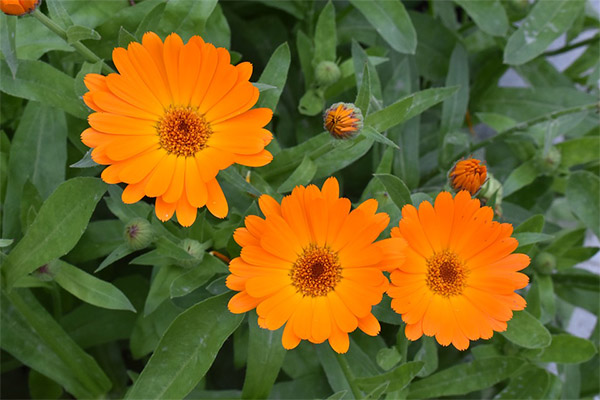
- In Slavic countries, the plant is rarely called calendula, here it is better known as "marigolds". This name appeared in the flower due to the shape of the seeds - they look like a cat's claw.
- In European countries, this flower is often called "Mary's gold."
- In Chinese medicine, calendula is used for the longest time, there this flower is considered one of the symbols of longevity.
- Gardeners plant calendula around the entire perimeter of the plot and use it as a border for beds when planting nightshade crops. This trick provides protection against Colorado beetles.
- Since ancient people could not explain the healing properties of this plant, they believed that it has a magical effect and scares away evil spirits that provoke illnesses.
As you can see, calendula is a universal medicine. If used correctly, this flower can serve not only as a decoration for the garden, but also as a powerful therapeutic and preventive measure!
«Important: all information on the site is provided exclusively in fact-finding purposes. Before applying any recommendations, consult with a profile specialist. Neither the editors nor the authors are liable for any possible harm caused materials. "

